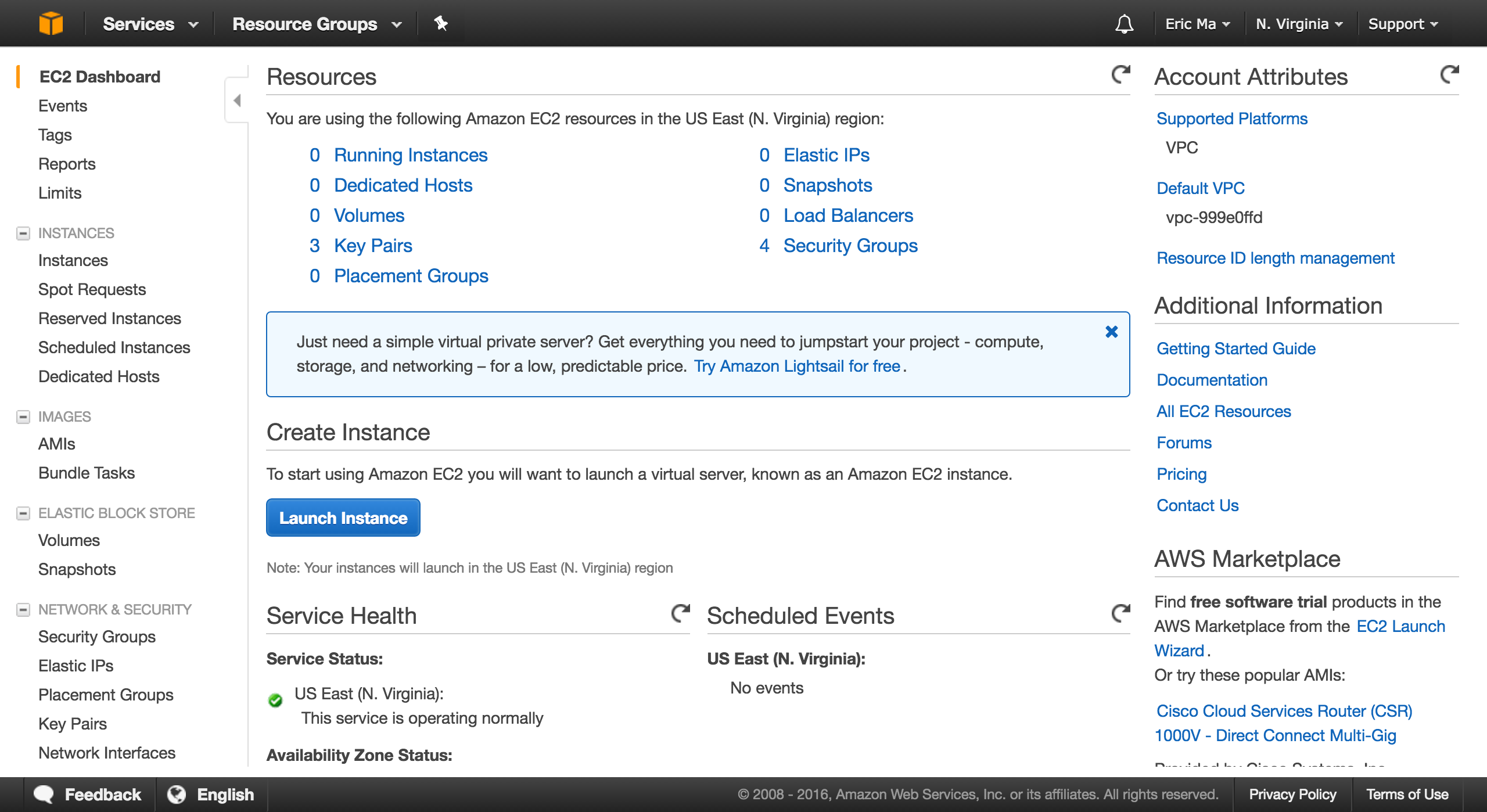
AWS landing page
I have worked through the steps necessary for setting up CLI access. See the CLI instructions for more information. There's a bunch of one-off setup necessary for using the CLI, but once that's all set up, the magic command, with square brackets around what you have to fill in, is:
$ aws ec2 run-instances \
--image-id ami-40d28157 \
--count 1 \
--instance-type g2.2xlarge \
--key-name [my-cli-keypair-name] \
--security-group-ids [my-security-group-id]If you'd prefer not to use the command line interface, read on.
Start by going to Amazon AWS and sign in using your Amazon.com account. You will arrive at the following console:

AWS landing page
Click on the big blue "Launch Instance" button. You will then arrive at the following page where you can select an "Amazon Machine Image" (AMI):
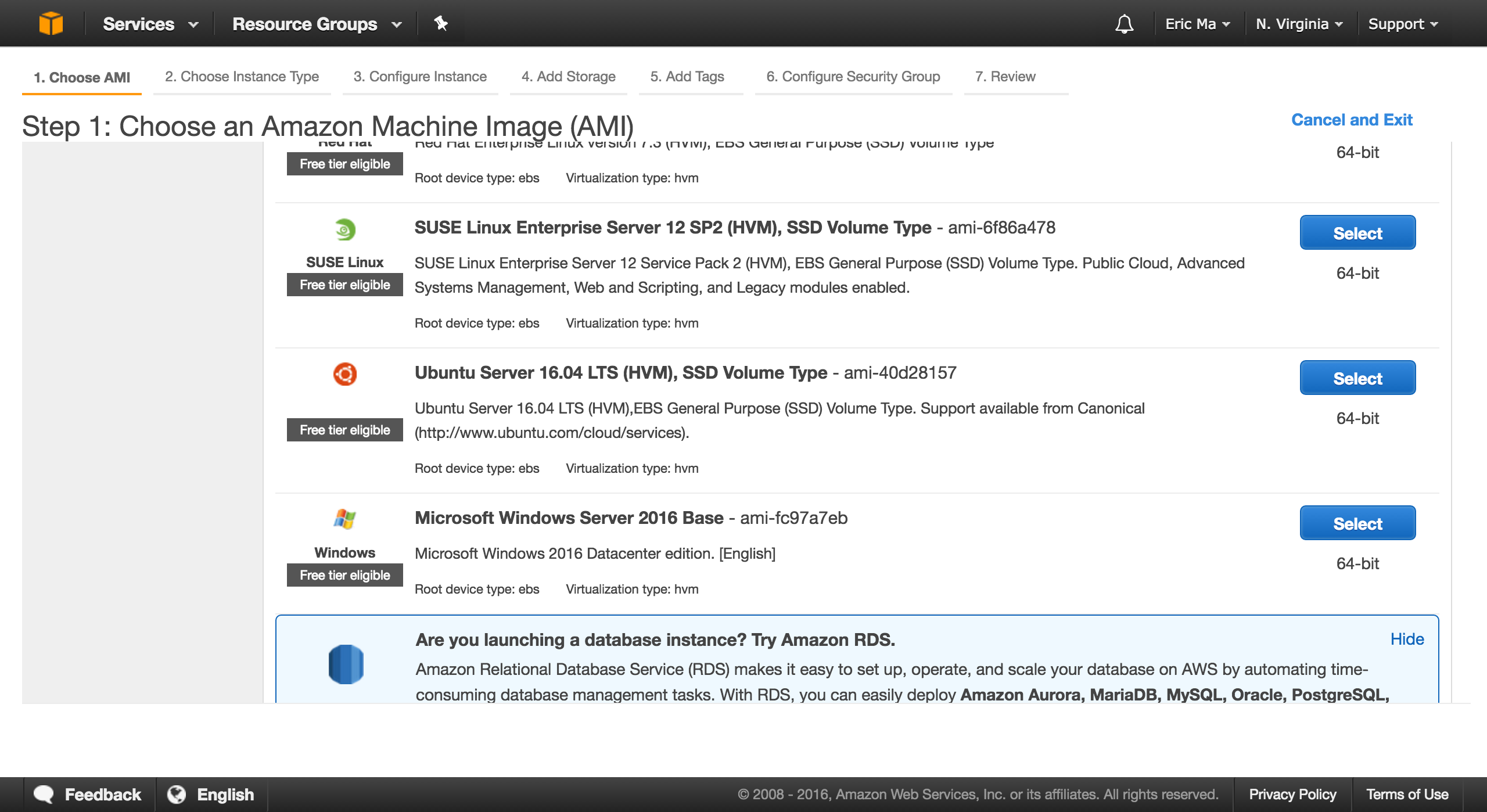
AMI selection page.
At this point, you are basically selecting an operating system to work with. Select the "Ubuntu Server"; the version number might change in the future, so I won't specify which version here. You now have to choose an "instance type", which specifies the hardware that will be used. Scroll down until you see the g2.2xlarge instance, select it, and click "Configure Instance Details".
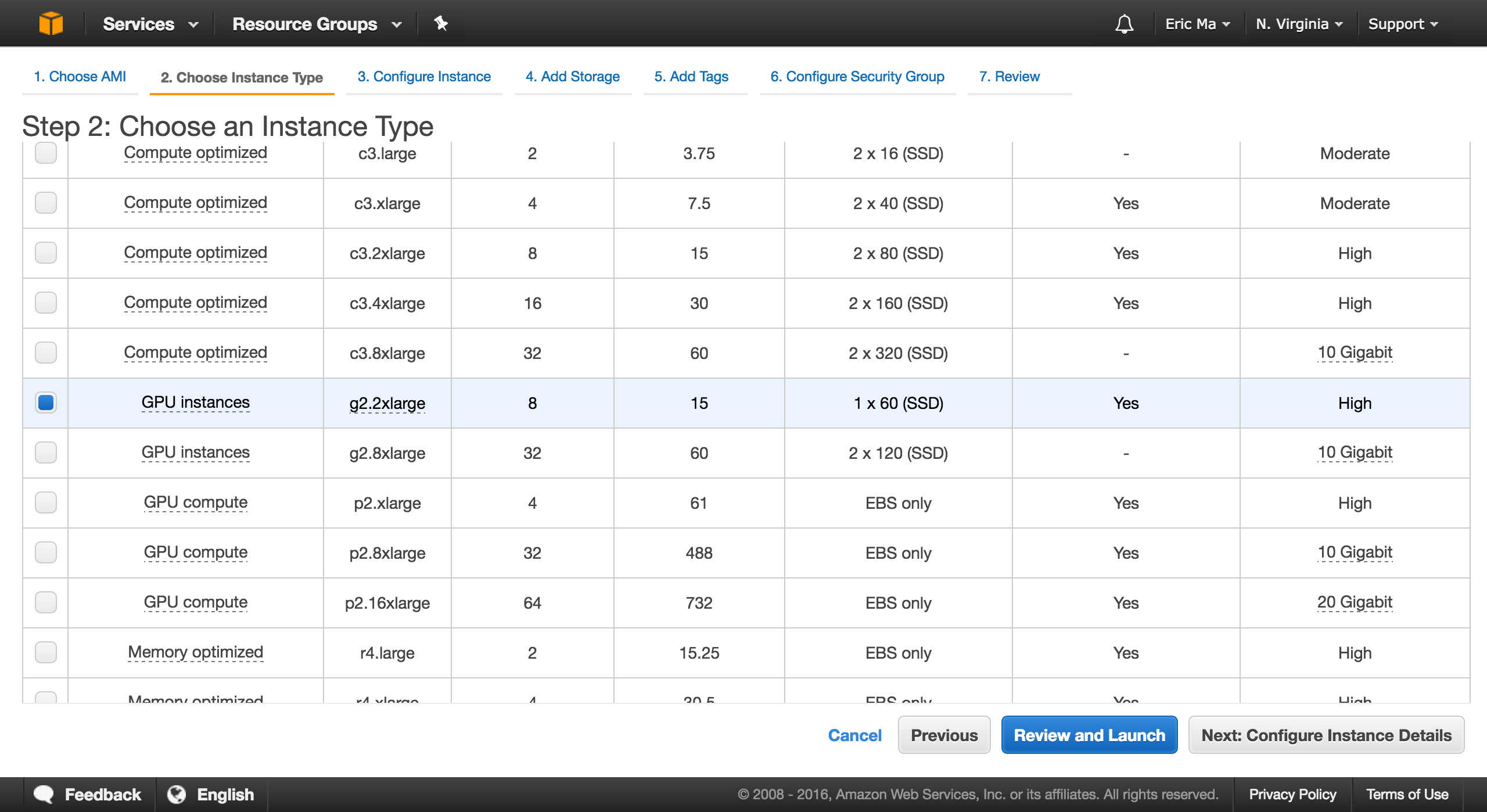
Instance selection page.
You will land on the "Configure Instance Details" page. Here, I have canonically not done anything, so you can click on to "Add Storage". On the "Add Storage" page, change the Size (GiB) of the Root volume to 60GB. This maxes out the size of the root volume, so you don't have to worry about other storage.

Instance storage page.
Click on to "Add Tags", and then click on to "Configure Security Group". Here, you want to enable SSH access via the terminal, and you'll want to give this security access some memorable name that you can identify for future use.
If this is the first time you're configuring a security group, set it up as follows:
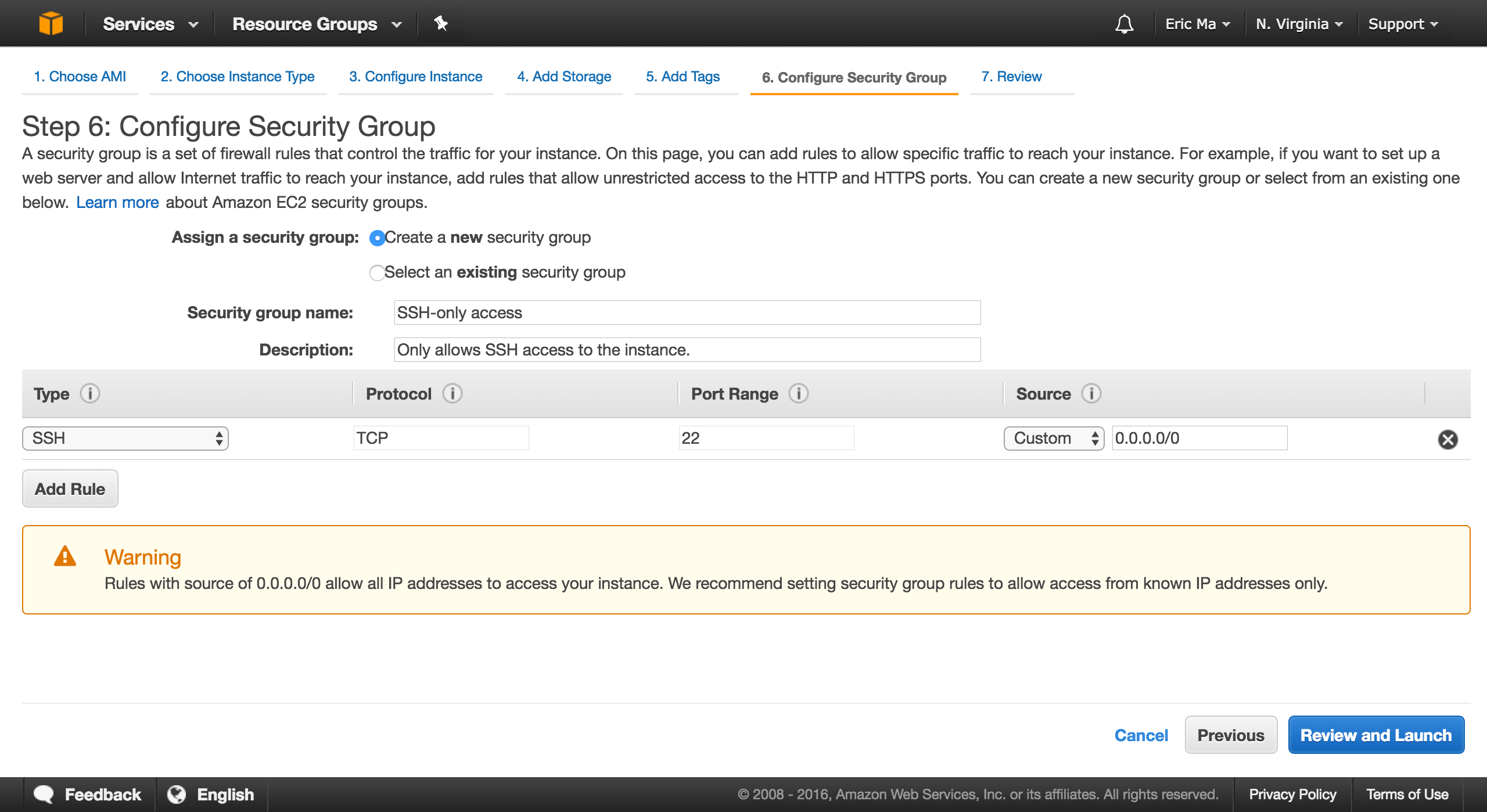
First-time setup
If you've already set up a security group before, click on "Select an existing security group", and select that security group.
Then, click on "Review and Launch", and then "Launch".
You will be prompted to select or create a "key pair"; this is for security purposes, and will allow you to SSH into the Amazon EC2 instance. Name the key pair name something memorable, say "beast", and then download the beast.pem file to your local disk.
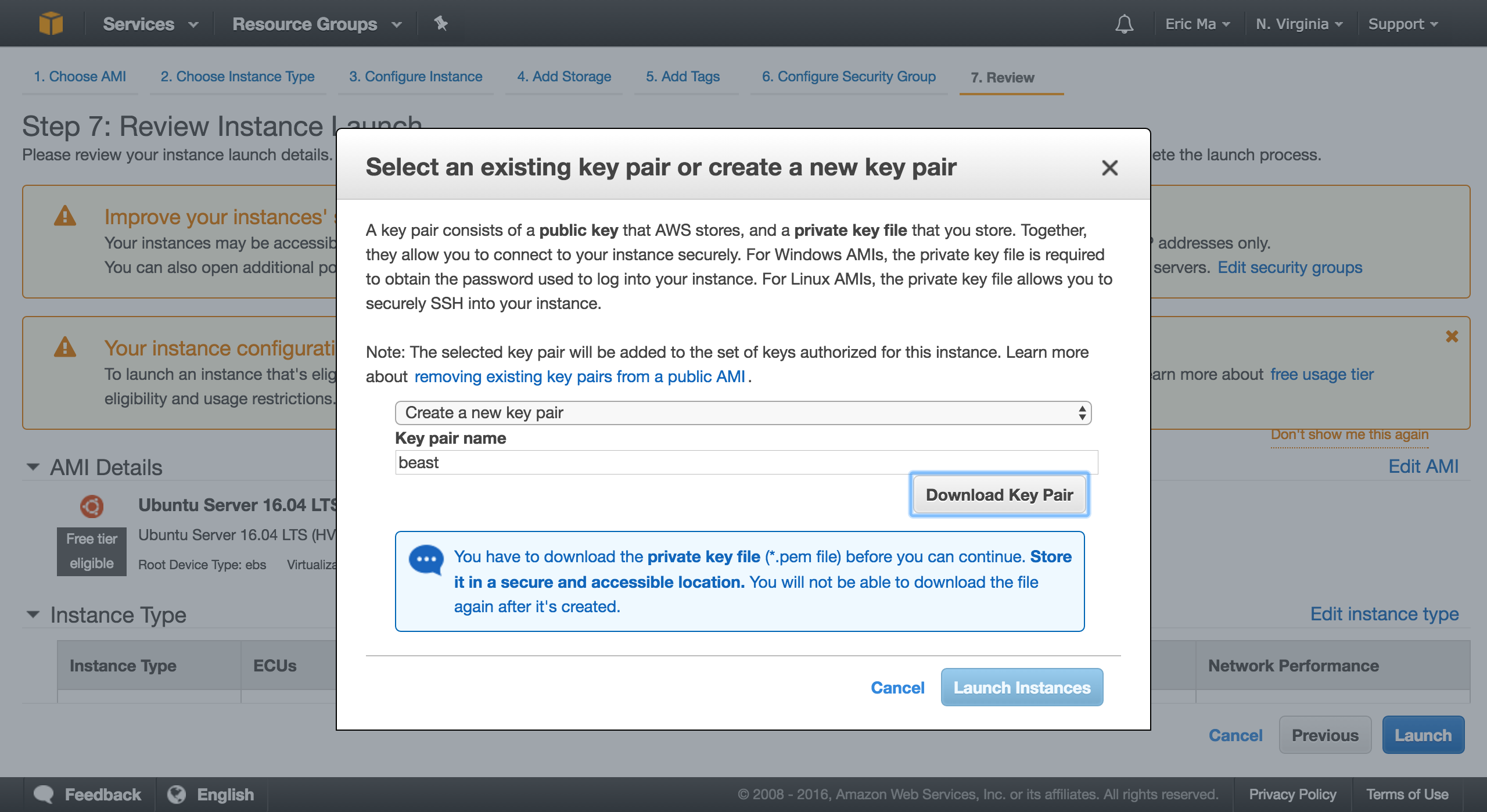
Create a key pair for accessing AWS.
Note: Some browsers will download it as beast.pem.txt. Be sure to then re-name it to beast.pem.
Once the instance is launched, you can go back to the console, and wait for it to be initialized. You will see the following page:
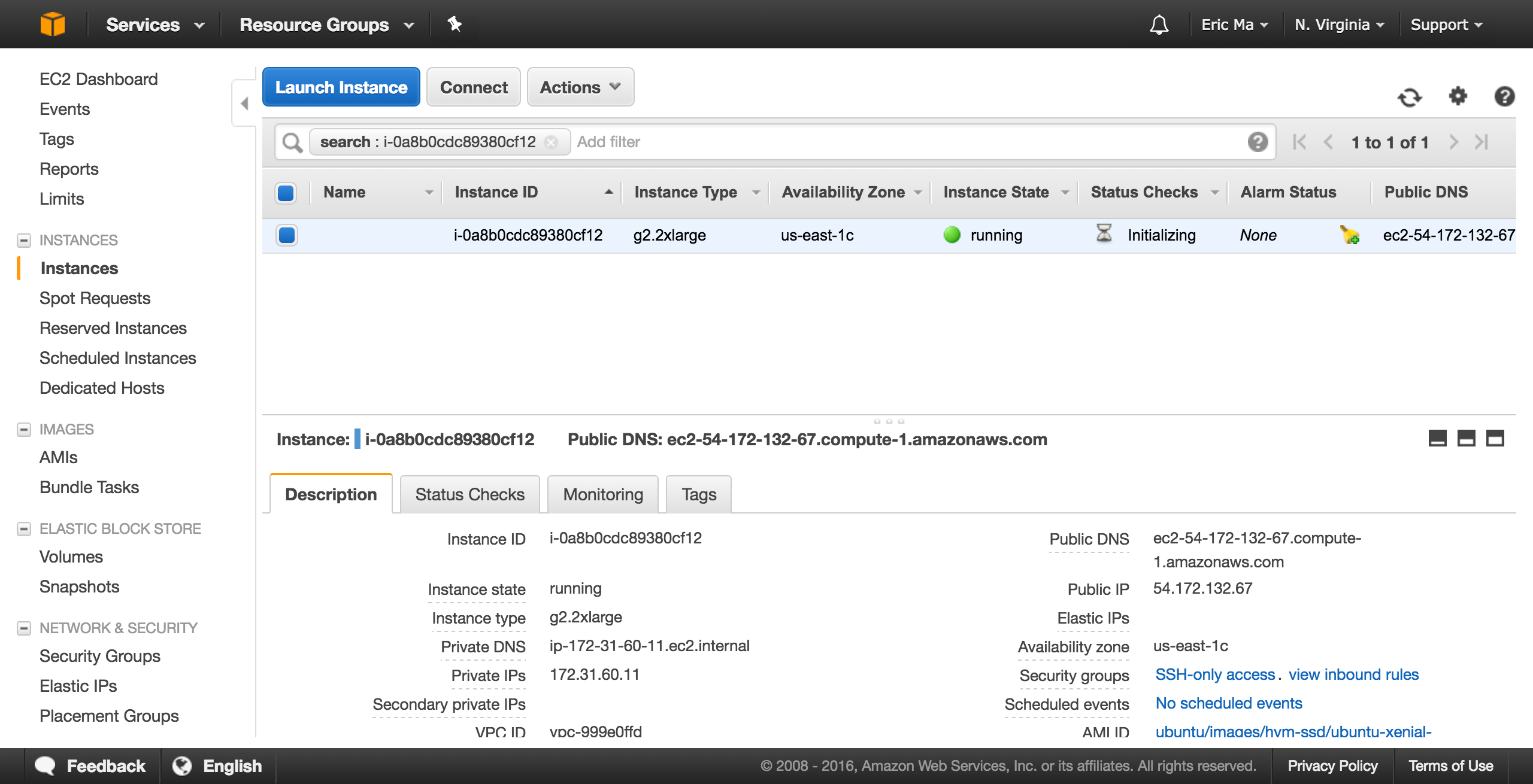
AWS console.
Take note of the "Public DNS", and make a copy of that.
If you are on a Unix-based machine, you can configure your SSH as follows:
beast.pem to the directory ~/.ssh/.Ensure that the following is entered into your SSH configuration file:
Host beast
HostName [AWS public DNS]
User ubuntu
IdentityFile ~/.ssh/beast.pemssh beast, and you will be SSH-ed into the Amazon instance!
Are you sure you want to continue connecting?, be sure to answer yes.Your Terminal session should look something like this:

SSH in iTerm2
Note: The bash commands here are predicated on using an Ubuntu Linux AMI. If you are using a different AMI, the commands will not work.
The overview is as follows:
In your terminal, invoke the nano text editor:
$ nano install.shThen, paste the following bash script code into the nano text editor.
sudo apt-get -y update # always a good idea to update and upgrade before doing anything else.
sudo apt-get -y upgrade
sudo apt-get -y install build-essential autoconf automake libtool subversion pkg-config openjdk-8-jdk
wget http://developer.download.nvidia.com/compute/cuda/repos/ubuntu1604/x86_64/cuda-repo-ubuntu1604_8.0.44-1_amd64.deb
sudo dpkg -i cuda-repo-ubuntu1604_8.0.44-1_amd64.deb
sudo apt-get update -y
sudo apt-get install -y cuda linux-image-extra-`uname -r` linux-headers-`uname -r` linux-image-`uname -r`
sudo apt-get install -y --no-install-recommends nvidia-361 nvidia-opencl-icd-361
git clone --depth=1 https://github.com/beagle-dev/beagle-lib.git
cd beagle-lib
./autogen.sh
./configure --prefix=$HOME
make install
make check
cd ..Exit out of nano by hitting the following key combinations:
Ctrl + X (exit)Y (say yes to save)Finally, run the install script using the following command: bash install.sh. Give it a bit of time (~5 min in total, in my experience), and then CUDA, OpenCL and BEAGLE will be installed.
Next up, we will have to edit your .bashrc using nano. Follow the following commands (of course, ignoring the $ symbol):
$ cd ~
$ nano .bashrcIn nano, use Ctrl + V to scroll all the way down to the the .bashrc file. Then, add the following two lines to it:
export LD_LIBRARY_PATH=$HOME/lib:$LD_LIBRARY_PATH
export PKG_CONFIG_PATH=$HOME/lib/pkgconfig:$PKG_CONFIG_PATH
export PATH=$HOME/beast/bin:$PATHIn that last line, we are going to make sure that the bash terminal will be able to find the BEAST binaries in the beast directory in our home folder.
Exit out of the terminal session using exit, and SSH back in using ssh beast, to allow the edited .bashrc to take effect.
Run the following commands in order:
cd ~
wget https://github.com/beast-dev/beast-mcmc/releases/download/v1.8.4/BEASTv1.8.4.tgz
tar -xvf BEASTv1.8.4.tgz
mv BEASTv1.8.4/ beast/ # this renames BEASTCheck that the BEAST binary is recognized:
$ which beast
/home/ubuntu/beast/bin/beastThe purpose of this part here is to save the current state of the instance as an AMI, so that you don't have to configure this again in the future. Switch back to your browser and go to the AWS console. Select the current running instance, then click on Actions > Image > Create Image. You will get the following screen:

How to save an AWS instance image
You will be able to create a new instance from this AMI, and use nearly identical SSH settings to get back into the instance.
Now you're ready to run BEAST! I'm going to pre-suppose here that you have an .xml file created using BEAUTI; you can use the scp command to upload it from your local drive into the Amazon instance. An example command is as such:
$ scp [my_xml_file].xml beast:~/path/to/my/directory/.Naturally, replace /path/to/my/directory/ with the directory on beast where you want to store the XML file.
To run BEAST while taking advantage of the GPU using BEAGLE, run the following commands:
$ beast -beagle -beagle_GPU -beagle_SSE -beagle_cuda [my_xml_file].xmlThat will be the command that will let you take advantage of the GPU while using BEAST.
In a single test, using this workflow and comparing it to a compute cluster that I have access to (MIT's Rous), on the same 10 million chain MCMC, Rous performed at 1.1-1.2 hours/million chains, while Amazon's GPU instance (K520 GRID) performed at 0.24-0.27 hours/million chains, gaining approximately 5-6 fold performance.